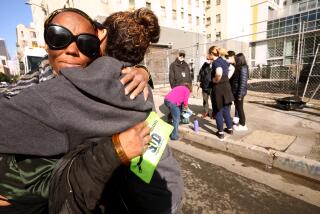Health Department Peddles a Regimen for New Yorkers
NEW YORK — Elizabeth Drackett, carrying a blue canvas bag filled with medical forms, reminder cards, stickers, special passports and posters of celebrities urging cancer screenings, is visiting doctors in Harlem. Printed in large letters on her tote is the name of her employer, the New York City Department of Health and Mental Hygiene.
Drackett’s visits are an integral part of “Take Care of New York,” an ambitious program designed to cut the death rate in the city by 2008. Officials said the effort was one of the most comprehensive in the health department’s 138-year history.
“We have spent two years collecting data on the vital signs of New York, our patient,” said Dr. Thomas R. Frieden, the city’s Health Commissioner. “Now we are recommending a treatment regimen.”
The focus is on the persistent illnesses that kill most people, such as heart disease, cancer and AIDS. Remedies include: distributing free nicotine patches to smokers, recommending to provide free condoms in gay bars, increasing the number of patients screened for colon and breast cancer, and promoting the expansion of health insurance coverage for employees of small companies.
The program borrows a page from the playbook of pharmaceutical companies that routinely send representatives to physicians’ offices with health information and samples of new and established drugs they are promoting.
Drackett, who was born in Harlem 38 years ago and whose mother still lives in the upper Manhattan neighborhood, is seeking to enlist doctors in a series of campaigns designed to improve health that compose the core of “Take Care New York.”
After a short walk along 116th Street, she enters a storefront clinic to talk to Dr. Regina Pozner, who has been in practice for 51 years, 23 of them in Harlem. Pozner routinely treats such illnesses as diabetes, arthritis, heart disease, hypertension, asthma and infections -- maladies common in the community and whose consequences are magnified by poverty. It is precisely these kinds of problems the health department is trying to diminish.
“We had a very successful flu season. I didn’t have any senior citizens with flu,” Pozner told Drackett. “I spent $3,000 on flu vaccine. I say, ‘Do you want a flu shot?’ and most of my patients say, ‘Yes.’ ”
“Beautiful!” Drackett said.
Drackett’s mission is stressing the need for people older than 50 to have a colonoscopy and for doctors to start planning for the next flu season.
“We had a few patients who agreed to have colonoscopies,” Pozner said, “and we had two polyps. They were negative.”
The 78-year-old physician also looks out for the interests of her patients beyond her small office, speaking up for those who need better phone or electric service, or food stamps.
Pozner said among her challenges is getting patients to listen to and follow instructions -- which is one the things the health department program hopes to improve.
Before Drackett heads to her next doctor’s office, she leaves information for Pozner to give patients about a walk-in cancer-screening clinic at Harlem Hospital and a supply of medical record booklets designed as passports for patients to carry.
The goals of “Take Care New York” include helping 300,000 more people find a regular doctor, cutting the number of adults who smoke by 240,000, convincing 200,000 more people 50 and older to be screened for colon cancer, and 90,000 more women to have mammograms. Public health officials want 150,000 more people 65 or older to get annual flu shots.
The administration of Mayor Michael R. Bloomberg predicts these steps will save thousands of lives and prevent hundreds of thousands of illnesses each year.
“This health policy is the first step toward fundamental change in the health landscape of New York City,” concluded a report prepared by the health department which outlines dozens of activities and policy directions. Some build on existing programs while others require new efforts.
Among program recommendations are exploring the possibility of requiring businesses that hold city contracts to carry basic health insurance for their workers and encouraging fast-food restaurants to use healthier ingredients and cooking techniques.
In neighborhoods with high rates of infant mortality, plans are underway to begin home visits by public health workers to first-time mothers within a month of childbirth.
“It has a very heavy focus on prevention,” said Dr. Allan Rosenfield, dean of the Mailman School of Public Health at Columbia University. “It is a mixture of tried and true techniques and innovations.”
“The key is setting an agenda based on data,” explained Frieden. “What’s new and different is the proactive focus.”
The commissioner said that New York’s agenda was based in part on the experience of the Los Angeles County Health Department, which began surveys monitoring the health of its population in 1997. The surveys have become increasingly sophisticated over the years, providing data for more than 60 indicators of health such as obesity, poverty, parental support, prenatal care, tobacco use, insurance coverage and more than a dozen diseases. The results are broken down by communities.
Calling on doctors to push a Health Department’s agenda takes persistence and sensitivity. So, far, the program has been limited to Harlem, South Bronx and the Bedford-Stuyvesant and Bushwick sections of Brooklyn, where the needs are greatest.
“We are not there to regulate. We are there to add value. We want to be a resource and provide information that will help [doctors] in their practice,” said Kelly Larson, the program’s director at the health department.
As she made her rounds to doctors’ offices, making personal contact in the support physicians in delivering health care, Drackett agreed: “We are just here to help.”
More to Read
Sign up for Essential California
The most important California stories and recommendations in your inbox every morning.
You may occasionally receive promotional content from the Los Angeles Times.










